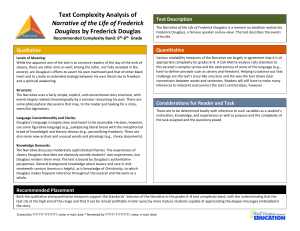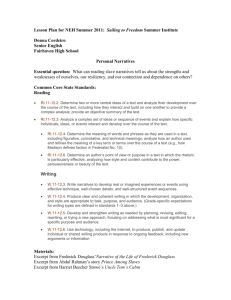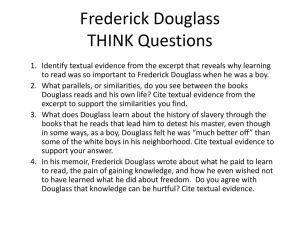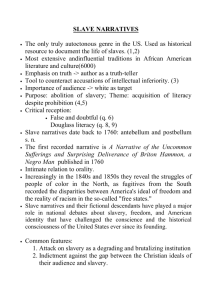Narration, Authentication and Authorial Control article
advertisement
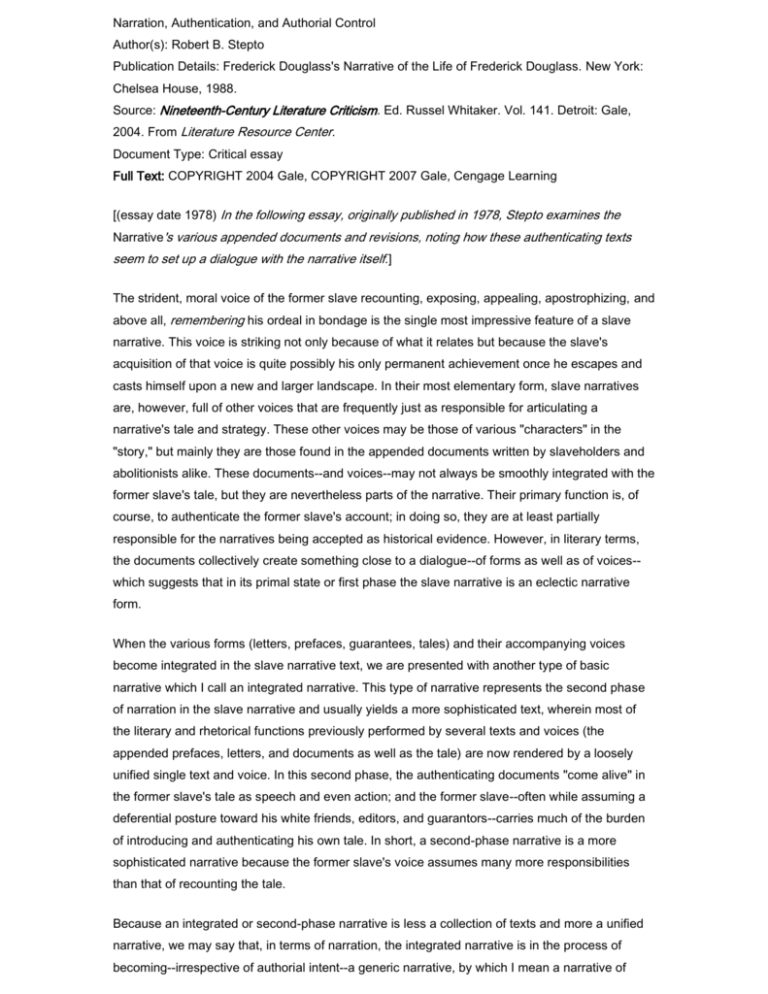
Narration, Authentication, and Authorial Control Author(s): Robert B. Stepto Publication Details: Frederick Douglass's Narrative of the Life of Frederick Douglass. New York: Chelsea House, 1988. Source: Nineteenth-Century Literature Criticism. Ed. Russel Whitaker. Vol. 141. Detroit: Gale, 2004. From Literature Resource Center. Document Type: Critical essay Full Text: COPYRIGHT 2004 Gale, COPYRIGHT 2007 Gale, Cengage Learning [(essay date 1978) In the following essay, originally published in 1978, Stepto examines the Narrative's various appended documents and revisions, noting how these authenticating texts seem to set up a dialogue with the narrative itself.] The strident, moral voice of the former slave recounting, exposing, appealing, apostrophizing, and above all, remembering his ordeal in bondage is the single most impressive feature of a slave narrative. This voice is striking not only because of what it relates but because the slave's acquisition of that voice is quite possibly his only permanent achievement once he escapes and casts himself upon a new and larger landscape. In their most elementary form, slave narratives are, however, full of other voices that are frequently just as responsible for articulating a narrative's tale and strategy. These other voices may be those of various "characters" in the "story," but mainly they are those found in the appended documents written by slaveholders and abolitionists alike. These documents--and voices--may not always be smoothly integrated with the former slave's tale, but they are nevertheless parts of the narrative. Their primary function is, of course, to authenticate the former slave's account; in doing so, they are at least partially responsible for the narratives being accepted as historical evidence. However, in literary terms, the documents collectively create something close to a dialogue--of forms as well as of voices-which suggests that in its primal state or first phase the slave narrative is an eclectic narrative form. When the various forms (letters, prefaces, guarantees, tales) and their accompanying voices become integrated in the slave narrative text, we are presented with another type of basic narrative which I call an integrated narrative. This type of narrative represents the second phase of narration in the slave narrative and usually yields a more sophisticated text, wherein most of the literary and rhetorical functions previously performed by several texts and voices (the appended prefaces, letters, and documents as well as the tale) are now rendered by a loosely unified single text and voice. In this second phase, the authenticating documents "come alive" in the former slave's tale as speech and even action; and the former slave--often while assuming a deferential posture toward his white friends, editors, and guarantors--carries much of the burden of introducing and authenticating his own tale. In short, a second-phase narrative is a more sophisticated narrative because the former slave's voice assumes many more responsibilities than that of recounting the tale. Because an integrated or second-phase narrative is less a collection of texts and more a unified narrative, we may say that, in terms of narration, the integrated narrative is in the process of becoming--irrespective of authorial intent--a generic narrative, by which I mean a narrative of discernible genre such as history, fiction, essay, or autobiography. This process is no simple "gourd vine" activity: An integrated narrative does not become a generic narrative "overnight," and, indeed, there are no assurances that in becoming a new type of narrative it is transformed automatically into a distinctive generic text. What we discover, then, is a third phase to slave narrative narration wherein two developments may occur: The integrated narrative (Phase II) is dominated either by its tale or by its authenticating strategies. In the first instance, the narrative and moral energies of the former slave's voice and tale so resolutely dominate those of the narrative's authenticating machinery (voices, documents, rhetorical strategies) that the narrative becomes in thrust and purpose far more metaphorical than rhetorical. When the integrated narrative becomes in this way a figurative account of action, landscape, and heroic selftransformation, it is so close generically to history, fiction, and autobiography that I term it a generic narrative. In the second instance, the authenticating machinery either remains as important as the tale or actually becomes, usually for some purpose residing outside the text, the dominant and motivating feature of the narrative. Since this is also a sophisticated narrative phase, figurative presentations of action, landscape, and self may also occur, but such developments are rare and always ancillary to the central thrust of the text. When the authenticating machinery is dominant in this fashion, the integrated narrative becomes an authenticating narrative. As these remarks suggest, one reason for investigating the phases of slave narrative narration is to gain a clearer view of how some slave narrative types become generic narratives and how, in turn, generic narratives--once formed, shaped, and set in motion by certain distinctly AfroAmerican cultural imperatives--have roots in the slave narratives. This bears as well on our ability to distinguish between narrative modes and forms and to describe what we see. When, for example, a historian or literary critic calls a slave narrative an autobiography, what he sees is, most likely, a narrative told in the first person that possesses literary features distinguishing it from the ordinary documents providing historical and sociological data. But a slave narrative is not necessarily an autobiography. We need to know the finer shades between the more easily discernible categories of narration, and we must discover whether these stops arrange themselves in progressive, contrapuntal, or dialectic fashion--or whether they possess any arrangement at all. As the scheme described above and diagrammed below suggests, I believe there are at least four identifiable modes of narration within the slave narrative, all of which have a direct bearing on the development of subsequent Afro-American narrative forms. Phase I: basic narrative (a): "eclectic narrative"--authenticating documents and strategies (sometimes including one by the author of the tale) appended to the tale Phase II: basic narrative (b): "integrated narrative"--authenticating documents and strategies integrated into the tale and formally becoming voices and/or characters in the tale Phase III: (a) "generic narrative"--authenticating documents and strategies are totally subsumed by the tale; the slave narrative becomes an identifiable generic text, e.g., autobiography, etc. (b) "authenticating narrative"--the tale is subsumed by the authenticating strategy; the slave narrative becomes an authenticating document for other, usually generic, texts, e.g., novel, history II What we observe in the first two phases of slave narrative narration is the former slave's ultimate lack of control over his own narrative occasioned primarily by the demands of audience and authentication. This dilemma is not unique to the authors of these narratives; indeed, many modern black writers still do not control their personal history once it assumes literary form. For this reason, Frederick Douglass's Narrative of the Life of Frederick Douglass, an American Slave, Written by Himself (1845) seems all the more a remarkable literary achievement. Because it contains several segregated narrative texts--a preface, a prefatory letter, the tale, an appendix--it appears to be, in terms of the narrative phases, a rather primitive slave narrative. But each of the ancillary texts seems to be drawn to the tale by some sort of extraordinary gravitational pull or magnetic attraction. There is, in short, a dynamic energy between the tale and each supporting text; the Douglass narrative is an integrated narrative of a very special order. While the integrating process does, in a small way, pursue the conventional path of creating characters out of authenticating texts (William Lloyd Garrison silently enters Douglass's tale at the very end), its new and major thrust is the creation of that aforementioned energy that binds the supporting texts to the tale while at the same time removing them from participation in the narrative's rhetorical and authenticating strategies. In short, Douglass's tale dominates the narrative and does so because it alone authenticates the narrative. The introductory texts to the tale are two in number: a preface by William Lloyd Garrison, the famous abolitionist and editor of The Liberator; and a "Letter from Wendell Phillips, Esq.," who was equally renowned as an abolitionist, a crusading lawyer, and a judge. In theory, each of these introductory documents should be a classic guarantee written almost exclusively to a white reading public, concerned primarily and ritualistically with the white validation of a newfound black voice, and removed from the tale in such ways that the guarantee and tale vie silently and surreptitiously for control of the narrative as a whole. But these entries simply are not fashioned that way. To be sure, Garrison offers a conventional guarantee when he writes: Mr. DOUGLASS has very properly chosen to write his own Narrative, in his own style, and according to the best of his ability, rather than to employ some one else. It is, therefore, entirely his own production; and ... it is, in my judgment, highly creditable to his head and heart. And Phillips, while addressing Douglass, most certainly offers a guarantee to "another" audience as well: Every one who has heard you speak has felt, and, I am confident, every one who reads your book will feel, persuaded that you give them a fair specimen of the whole truth. No one-sided portrait,--no wholesale complaints,--but strict justice done, whenever individual kindliness has neutralized, for a moment, the deadly system with which it was strangely allied. But these passages dominate neither the tone nor the substance of their respective texts. Garrison is far more interested in writing history (specifically that of the 1841 Nantucket AntiSlavery Convention and the launching of Douglass's career as a lecture agent for various antislavery societies) and recording his own place in it. His declaration, "I shall never forget his [Douglass's] first speech at the convention," is followed shortly thereafter by " I rose, and declared that Patrick Henry of revolutionary fame, never made a speech more eloquent in the case of liberty. ... I reminded the audience of the peril which surrounded this self-emancipated young man. ... I appealed to them, whether they would ever allow him to be carried back into slavery,-law or no law, constitution or no constitution" (italics added). His preface ends, not with a reference to Douglass or to his tale, but with an apostrophe very much like one he would use to exhort and arouse an antislavery assembly. In short, with the following cry, Garrison hardly guarantees Douglass's tale but reenacts his own abolitionist career instead: Reader! are you with the man-stealers in sympathy and purpose, or on the side of their downtrodden victims? If with the former, then are you the foe of God and man. If with the latter, what are you prepared to do and dare in their behalf? Be faithful, be vigilant, be untiring in your efforts to break every yoke, and let the oppressed go free. Come what may--cost what may--inscribe on the banner which you unfurl to the breeze, as your religious and political motto--NO COMPROMISE WITH SLAVERY! NO UNION WITH SLAVEHOLDERS! In the light of this closure and (no matter how hard we try to ignore it) the friction that developed between Garrison and Douglass in later years, we might be tempted to see Garrison's preface at war with Douglass's tale for authorial control of the narrative as a whole. Certainly, there is a tension, but that tension is stunted by Garrison's enthusiasm for Douglass's tale: This Narrative contains many affecting incidents, many passages of great eloquence and power; but I think the most thrilling one of them all is the description DOUGLASS gives of his feelings, as he stood soliloquizing respecting his fate, and the chances of his one day being a free man. ... Who can read that passage, and be insensible to its pathos and sublimity?(italics added) What Garrison does, probably subconsciously, is an unusual and extraordinary thing--he becomes the first guarantor we have seen who not only directs the reader to the tale but also acknowledges the tale's singular rhetorical power. Thus, Garrison enters the tale by being at the Nantucket Convention with Douglass in 1841 and by authenticating the impact of the tale, not its facts. He fashions his own apostrophe, but finally he remains a member of Douglass's audience far more than he assumes the posture of a competing or superior voice. In this way, Garrison's preface stands outside Douglass's tale but is steadfastly bound to it. This is even more so the case for Wendell Phillips's "Letter." It contains passages that seem to be addressed to credulous readers in need of a "visible" authority's guarantee, but by and large the "Letter" is directed to Frederick Douglass alone. It opens with "My Dear Friend," and there are many extraliterary reasons for wondering initially if the friend is actually Frederick. Shortly thereafter, however, Phillips declares, "I am glad the time has come when the 'lions write history,'" and it becomes clear that he not only addresses Douglass but also writes in response to the tale. These features, plus Phillips's specific references to how Douglass acquired his "ABC" and learned of "where the 'white sails' of the Chesapeake were bound," serve to integrate Phillips's "Letter" into Douglass's tale. Above all, we must see in what terms the "Letter" is a cultural and linguistic event: Like the Garrison document, it presents its author as a member of Douglass's audience, but the act of letterwriting, of correspondence, implies a moral and linguistic parity between a white guarantor and black author that we have not seen before and that we do not always see in American literary history after 1845. In short, the tone and posture initiated in Garrison's preface are completed and confirmed in Phillips's "Letter," and while these documents are integrated into Douglass's tale, they remain segregated outside the tale in the all-important sense that they yield Douglass sufficient narrative and rhetorical space in which to render personal history in--and as--a literary form. What marks Douglass's narration and control of his tale is his extraordinary ability to pursue several types of writing with ease and with a degree of simultaneity. The principal types of writing we discover in the tale are syncretic phrasing, introspective analysis, internalized documentation, and participant-observation. Of course, each of these types has its accompanying authorial posture, the result being that even the telling of the tale (as distinct from the content of the tale) yields a portrait of a complex individual marvelously facile in the tones, shapes, and dimensions of his voice. Douglass's syncretic phrasing is often discussed, and the passage most widely quoted is probably "My feet have been so cracked with the frost, that the pen with which I am writing might be laid in the gashes." The remarkable clarity of this language needs no commentary, but what one admires as well is Douglass's ability to startlingly conjoin past and present and to do so with images that not only stand for different periods in his personal history but also, in their fusion, speak of his evolution from slavery to freedom. The pen, symbolizing the quest for literacy fulfilled, actually takes measure of the wounds of the past, and this measuring process becomes a metaphor in and of itself for the artful composition of travail transcended. While I admire this passage, the syncretic phrases I find even more intriguing are those that pursue a kind of acrid punning upon the names of Douglass's oppressors. A minor example appears early in the tale, when Douglass deftly sums up an overseer's character by writing, "Mr. Severe was rightly named: he was a cruel man." Here, Douglass is content with "glossing" the name; but late in the tale, just before attempting to escape in 1835, Douglass takes another oppressor's name and does not so much gloss it or play with it as work upon it to such an extent that, riddled with irony, it is devoid of its original meaning: At the close of the year 1834, Mr. Freeland again hired me of my master, for the year 1835. But, by this time, I began to want to live upon free land as well as with Freeland; and I was no longer content, therefore, to live with him or any other slaveholder. Of course, this is effective writing--far more effective than what is found in the average slave narrative--but the point I wish to make is that Douglass seems to fashion these passages for both his readership and himself. Each example of his wit and increasing facility with language charts his ever-shortening path to literacy; thus, in their way, Douglass's syncretic phrases reveal his emerging comprehension of freedom and literacy and are another introspective tool by which he may benchmark his personal history. But the celebrated passages of introspective analysis are even more pithy and direct. In these, Douglass fashions language as finely honed and balanced as an aphorism or Popean couplet, and thereby orders his personal history with neat, distinct, and credible moments of transition. When Mr. Auld forbids Mrs. Auld to instruct Douglass in the ABC, for example, Douglass relates: From that moment, I understood the pathway from slavery to freedom. ... Whilst I was saddened by the thought of losing the aid of my kind mistress, I was gladdened by the invaluable instruction which, by the merest accident, I gained from my master. The clarity of Douglass's revelation is as unmistakable as it is remarkable. As rhetoric, the passage is successful because its nearly extravagant beginning is finally rendered quite acceptable by the masterly balance and internal rhyming of "saddened" and "gladdened," which is persuasive because it is pleasant and because it offers the illusion of a reasoned conclusion. Balance is an important feature of two other equally celebrated passages that quite significantly open and close Douglass's telling of his relations with Mr. Covey, an odd (because he worked in the fields alongside the slaves) but vicious overseer. At the beginning of the episode, in which Douglass finally fights back and draws Covey's blood, he writes: You have seen how a man was made a slave; you shall see how a slave was made a man. And at the end of the episode, to bring matters linguistically and narratively full circle, Douglass declares: I now resolved that, however long I might remain a slave in form, the day has passed forever when I could be a slave in fact. I did not hesitate to let it be known of me, that the white man who expected to succeed in whipping, must also succeed in killing me. The sheer poetry of these statements is not lost on us, nor is the fact of why the poetry was created in the first place. One might suppose that in another age Douglass's determination and rage might take a more effusive expression, but I cannot imagine that to be the case. In the first place, his linguistic model is obviously scriptural; and in the second, his goal is the presentation of a historical self, not the record of temporary hysteria. This latter point persuades me that Douglass is about the business of discovering how personal history may be transformed into autobiography. Douglass's passages of introspective analysis almost single-handedly create fresh space for themselves in the American literary canon. Instead of reproducing letters and other documents written by white guarantors within the tale or transforming guarantors into characters, Douglass internalizes documents that, like the syncretic and introspective passages, order his personal history. For example, Douglass's discussion of slave songs begins with phrases such as "wild songs" and "unmeaning jargon" but concludes, quite typically for him, with a study of how he grew to "hear" the songs and how the hearing affords yet another illumination of his path from slavery to freedom: I did not, when a slave, understand the deep meaning of those rude and apparently incoherent songs. I was myself within the circle; so that I neither saw nor heard as those without might see and hear. They told a tale of woe which was then altogether beyond my feeble comprehension. ... Every tone was a testimony against slavery, and a prayer to God for deliverance from chains. The hearing of those wild notes always depressed my spirit, and filled me with ineffable sadness. I have frequently found myself in tears while hearing them. The mere recurrence to those songs, even now, afflicts me; and while I am writing these lines, an expression of feeling has already found its way down my cheek. The tears of the past and present interflow, and Douglass not only documents his saga of enslavement but also, with typical recourse to syncretic phrasing and introspective analysis, advances his presentation of self. Douglass's other internalized documents are employed with comparable efficiency as we see in the episode where he attempts an escape in 1835. In this episode, the document reproduced is the pass or "protection" Douglass wrote for himself and his compatriots in the escape plan: "This is to certify that I, the undersigned, have given the bearer, my servant, full liberty to go to Baltimore, and spend the Easter holidays. Written with mine own hand, &c., 1835."WILLIAM HAMILTON, "Near St. Michael's, in Talbot county, Maryland." The protection exhibits Douglass's increasingly refined sense of how to manipulate language--he has indeed come a long way from that day Mr. Auld halted his ABC lessons--but even more impressive, I believe, is the act of reproducing the document itself. We know from the tale that when their scheme was thwarted, each slave managed to destroy his pass, so Douglass reproduces his language from memory, and there is no reason to doubt a single jot of his recollection. My point here is simply that Douglass can draw so easily from the well-springs of memory because the protection is not a mere scrap of memorabilia but rather a veritable road sign on his path to freedom and literacy. In this sense, his protection assumes a place in AfroAmerican letters as a key antecedent to such documents as the fast-yellowing notes of James Weldon Johnson's Ex-Coloured Man and "The Voodoo of Hell's Half Acre" in Richard Wright's Black Boy. All of the types of narrative discourse discussed thus far reveal features of Douglass's particular posture as a participant-observer narrator. But the syncretic phrases, introspective studies, and internalized documents only exhibit Douglass as a teller and doer, and part of the great effect of his tale depends upon what Douglass does not tell, what he refuses to reenact in print. Late in the tale, at the beginning of chapter 11, Douglass writes: I now come to that part of my life during which I planned, and finally succeeded in making, my escape from slavery. But before narrating any of the peculiar circumstances, I deem it proper to make known my intention not to state all the facts connected with the transaction. ... I deeply regret the necessity that impels me to suppress any thing of importance connected with my experience in slavery. It would afford me great pleasure indeed, as well as materially add to the interest of my narrative, were I at liberty to gratify a curiosity, which I know exists. ... But I must deprive myself of this pleasure, and the curious gratification which such a statement would afford. I would allow myself to suffer under the greatest imputations which evil-minded men might suggest, rather than exculpate myself, and thereby run the hazard of closing the slightest avenue by which a brother slave might clear himself of the chains and fetters of slavery. It has been argued that one way to test a slave narrative's authenticity is by gauging how much space the narrator gives to relating his escape as opposed to describing the conditions of his captivity. If the adventure, excitement, and perils of the escape seem to be the raison d'être for the narrative's composition, then the narrative is quite possibly an exceedingly adulterated slave's tale or a bald fiction. The theory does not always work perfectly: Henry "Box" Brown's narrative and that of William and Ellen Craft are predominantly recollections of extraordinary escapes, and yet, as far as we can tell, these are authentic tales. But the theory nevertheless has great merit, and I have often wondered to what extent it derives from the example of Douglass's tale and emotionally, if not absolutely rationally, from his fulminations against those authors who unwittingly excavate the underground railroad and expose it to the morally thin mid-nineteenthcentury American air. Douglass's tale is spectacularly free of suspicion, because he never tells a detail of his escape to New York, and it is this marvelously rhetorical omission or silence that both sophisticates and authenticates his posture as a participant-observer narrator. When a narrator wrests this kind of preeminent authorial control from the ancillary voices "circling" his narrative, we may say that he controls the presentation of his personal history and that his tale is becoming autobiographical. In this light the last few sentences of Douglass's tale take on special meaning: But, while attending an anti-slavery convention at Nantucket, on the 11th of August, 1841, I felt strongly moved to speak. ... It was a severe cross, and I took it up reluctantly. The truth was, I felt myself a slave, and the idea of speaking to white people weighed me down. I spoke but a few moments, when I felt a degree of freedom, and said what I desired with considerable ease. From that time until now, I have been engaged in pleading the case of my brethren--with what success, and what devotion, I leave those acquainted with my labors to decide. With these words, the narrative, as many have remarked, comes full circle, taking us back, not to the beginning of the tale, but rather to Garrison's prefatory remarks on the Convention and Douglass's first public address. This return may be pleasing in terms of the sense of symmetry it affords, but it is also a remarkable feat of rhetorical strategy: Having traveled with Douglass through his account of his life, we arrive in Nantucket in 1841 to hear him speak and, in effect, to become, along with Mr. Garrison, his audience. The final effect is that Douglass reinforces his posture as an articulate hero while supplanting Garrison as the definitive historian of his past. Even more important, I think, is the final image Douglass bestows of a slave shedding his last fetter and becoming a man by first finding his voice and then, as sure as light follows dawn, speaking "with considerable ease." In one brilliant stroke, the quest for freedom and literacy implied from the start even by the narrative's title is resolutely consummated. The final text of the narrative, the appendix, is a discourse by Douglass on his view of Christianity and Christian practice as opposed to what he exposed in his tale to be the bankrupt, immoral faith of slaveholders. As rhetorical strategy, the discourse is effective generally because it lends weight and substance to what passes for a conventional complaint of slave narrative narrators and because Douglass's exhibition of faith can only enhance his already considerable posture as an articulate hero. But more specifically, the discourse is most efficacious because at its heart lies a vitriolic poem written by a Northern Methodist minister, which Douglass introduces by writing, I conclude these remarks by copying the following portrait of the religion of the south, (which is, by communion and fellowship, the religion of the north,) which I soberly affirm is "true to life," and without caricature or the slightest exaggeration. The poem is strong and imbued with considerable irony, but what we must appreciate here is the effect of the white Northerner's poem conjoined with Douglass's authentication of the poem. The tables are clearly reversed. Douglass has controlled his personal history and at the same time fulfilled the prophecy suggested in his implicit authentication of Garrison's preface: He has explicitly authenticated what is conventionally a white Northerner's validating text. Douglass's narrative thus offers what is unquestionably our best portrait in Afro-American letters of the requisite act of assuming authorial control. An author can go no further than Douglass did without writing all the texts constituting the narrative himself. Source Citation Stepto, Robert B. "Narration, Authentication, and Authorial Control." Frederick Douglass's Narrative of the Life of Frederick Douglass. Ed. Harold Bloom. New York: Chelsea House, 1988. 45-57. Rpt. in Nineteenth-Century Literature Criticism. Ed. Russel Whitaker. Vol. 141. Detroit: Gale, 2004. Literature Resources from Gale. Web. 29 Nov. 2010. Document URL http://go.galegroup.com/ps/i.do?&id=GALE%7CH1420058748&v=2.1&u=avl_auta&it=r&p=LitRG &sw=w
